Newsletter
Current
Previous
|
June 2007
|
|
Earley
Environmental
Group |
|
Newsletter June 2007
Issue 8
www.earleyenvironmentalgroup.co.uk |
Earley Old English 'Earnley -eagle wood' |
|
 Colours have a strong influence on us, and on wildlife too. Who would be so foolish as to wave a red flag at a bull! We talk of feeling blue, or being in a black mood; but green is a restful, calming colour, and some theatres have a Green Room to soothe performers’ nerves. One definition of green is ‘grass-coloured’, but language is a living thing and in recent years ‘green’ has come to stand for something far more potent than just a colour; it can describe a political party’s agenda, a company’s credentials, or an individual’s way of life. It is now also defined as “advocating protection of the environment”. Nearly every day newspapers and television programmes have items on ‘green’ matters, many of which are contradictory, and some couched in terms way above the heads of the average scientifically-challenged person. Too much talk of environmental issues may result in ‘green fatigue’. We may unknowingly be exposed to ‘green washing’ – spin put on unsound projects to make them appear more favourable than they are. Some individuals do their best in a small way to be green, but it is surprising to read that the results of a recent MORI poll showed 32% of people in the UK knew little or nothing of the threat of climate change; half of those who knew about it thought it was at least partly a natural process and only 11% thought it was up to individuals to change their behaviour. Colours have a strong influence on us, and on wildlife too. Who would be so foolish as to wave a red flag at a bull! We talk of feeling blue, or being in a black mood; but green is a restful, calming colour, and some theatres have a Green Room to soothe performers’ nerves. One definition of green is ‘grass-coloured’, but language is a living thing and in recent years ‘green’ has come to stand for something far more potent than just a colour; it can describe a political party’s agenda, a company’s credentials, or an individual’s way of life. It is now also defined as “advocating protection of the environment”. Nearly every day newspapers and television programmes have items on ‘green’ matters, many of which are contradictory, and some couched in terms way above the heads of the average scientifically-challenged person. Too much talk of environmental issues may result in ‘green fatigue’. We may unknowingly be exposed to ‘green washing’ – spin put on unsound projects to make them appear more favourable than they are. Some individuals do their best in a small way to be green, but it is surprising to read that the results of a recent MORI poll showed 32% of people in the UK knew little or nothing of the threat of climate change; half of those who knew about it thought it was at least partly a natural process and only 11% thought it was up to individuals to change their behaviour. |

How our ancestors eliminated many of our native mammals and birds, p.2
Litter problems in Earley, p.3
‘The Past Is A Foreign Country’ – read Alan Broodbank’s evocative look at his Earley childhood in the 1940s/50s, p.4
Earley is a hot-spot for stag beetles, harmless creatures, which are quite rare in some areas. Join the Great Stag Hunt, p.5
The early spring of 2007 - its impact on our Earley birds, p.7
Plus Regular Items:
Green Jargon, p3
A Look at Old Earley, p.5
News From Beyond Earley and Earley Sightings, p. 6
Forthcoming Events, p.8 |
Get to know your Earley
A stroll round Earley’s old historic lanes
No-one could pretend that Earley has the charm of, say, the Cotswolds but, for a short stroll or bike-ride, a circuit round the old lanes might serve well. Notice the remnants of old hedges and trees, particularly oaks, which once marked the line of the old lanes. You can join this circuit at any point.
Starting near the end of Beech Lane where it joins Rushey Way, take pedestrian lane on west side of Beech Lane (on opposite side of road to dead end of Beech Lane, (Shackels Farm Road in 1820) and, crossing Stockbury Close, continue till left turn where it joins old Radstock Lane. Follow lane, crossing Kerris Way, and after a few yards take filter on left which leads to underpass on Rushey Way. After underpass follow old lane heading south (in 1820 called Clark’s Farm Road) to junction with Cutbush Lane. (Note opposite gate to Rushey Mead, where old lane continued to Lower Earley Wood Farm and Loddon) Turn left at Cutbush Lane (vehicular road for short distance), (note Conygree Close on left: Conygree means rabbit warren) until reaching pedestrianised part of Cutbush Lane. Continue to junction with Carshalton Way, then either turn left to junction with Rushey Way (busy road), thence left back to Beech Lane, or, cross Carshalton Way at roundabout and continue on Cutbush. A few yards on right note Woodbine Close (the site of an old dwelling called Woodbine Cottage). Note road sign which shows where Cutbush becomes Gipsy Lane. Continue on Gipsy Lane to junction with Kilnsea Drive (vehicular road), and turn left to Rushey Way, then left to head back to Beech Lane.
For those who want more of a challenge, from Gipsy Lane turn left into Maiden Place car park. Continue north to Maiden Place Community Centre, cut across rough ground at side of Centre, turn right up old lane till you reach Rushey Way. (Steps up to Rushey Way.) Left to Beech Lane.
|
| Anyone with an interest in native wildlife and/or local history will find recently-published “Silent Fields”, pub.O.U.P., by Roger Lovegrove, Director of RSPB in Wales until retirement in 1997, a fascinating read. The book is the culmination of his six-year slog using parish registers, survival of which was often fragmentary, to research the war waged by man against native wildlife from the Middle Ages to the present day. He includes monographs on the mammals and birds targeted. The following gives the briefest idea of the book’s contents. |
A Campaign Of Extermination Against Our Native Wildlife |
EARLY HISTORY OF ELIMINATION
Early people in Britain started the killing and later, when they began to farm, anything that took the food out of their mouths was for the chop. The large mammals were eliminated early on. Any animal which possessed a fur had a hard time. The beaver was so valued for its fur and castor oil derived from it, it had disappeared from England long ago. Brown bear was prehistorically widespread in Britain but probably gone by the arrival of Anglo Saxons, who enjoyed hunting wolf, fox and boar. The wolf, an animal with an unfair reputation boosted by fairy tales, was once widespread and lasted several centuries longer. Fur, like today, became a fashion accessory in medieval times and smaller mammals became victims. The demand for fur lasted several hundred years, resulting in millions of small mammals being killed.
NOT-SO-GOLDEN TUDOR AGE FOR ANIMALS
When legislation was passed in the 16th century many of the large mammals had gone. Life was hard, disease and poor harvests often present; safeguarding food was essential. 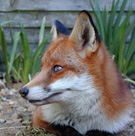 In 1566 legislation was introduced which required all parishes to levy money to pay for the killing of wildlife considered vermin. It was called ‘An Acte for the Preservation of Grayne’, a curious title since many of those on the list had no interest in grain, for instance: In 1566 legislation was introduced which required all parishes to levy money to pay for the killing of wildlife considered vermin. It was called ‘An Acte for the Preservation of Grayne’, a curious title since many of those on the list had no interest in grain, for instance:
for the Heade of any Byrde which is called the Kings Fyssher; one penny; for every Iron (Sea Eagle) (a curious inclusion because most had been eliminated from lowland areas and only one parish entry found for the Lake District) or Ospreyes Head Fower pence; for the Heades of everie Fox or Gray (badger) twelve pence.
The parish bounty hunters had to present the heads of the kill for payment to ‘two honest and substantial persons’, elected annually.
ADVENT OF FIELD SPORTS
After field enclosures large landowners were free to indulge their hobbies of huntin’ and shootin’ on their newly-enlarged estates. Gamekeepers had to protect their masters’ game from not only poachers but natural predators, leading to the slaughter of some of our magnificent birds of prey. With the advent of rail it was easy for Victorian gents and their retinue to make fast journeys to where the sport was best, and this bonanza lasted until the outbreak of World War I. Many of the gamekeepers and their masters marched to the trenches and didn’t return. The party was over.
SOME NOT INCLUDED IN THE TUDOR ACT ALSO SUFFERED
Bats, owls (nuisance in church), red squirrels (woodland threat, Squirrel Clubs were formed to kill them), brown hares and sparrows(agricultural nuisance, Sparrow Clubs formed). Sparrows suffered horrendously from parish bounty-hunters; using 28 (Old) Berkshire parish records, (but not Sonning/Earley) Roger Lovegrove commented Berkshire was one of the top killing counties, and estimated a total of three million sparrows (possibly an under-estimate) were killed overall in Berkshire.
The nearest parishes sampled, Swallowfield and Arborfield, were keen killers of sparrows, the latter killing 1,646 dozen or nearly 20,000 from 1745 to 1836, with the greatest killing from 1800 to 1836, when perhaps there was increased farming of crops. However, in spite of all the slaughter it is only in the last decade that numbers have approximately halved.
The PRESENT-DAY SITUATION and VARYING OPINIONS
Times and attitudes have changed. Wildlife conservation bodies proliferate, and we care deeply about wildlife, but there are still many conflicts; war is still waged between wildlife and its supporters on one side, and vested interests and hobbyists on the other. Roger Lovegrove thinks conservationists must be prepared to make compromises with ‘legitimate human interests’. Richard Mabey in the June BBC Wildlife Magazine has a different view. ‘Real threats to life and health are one thing. Nuisance, mess, missed targets and minor loss of income are another and not a legitimate excuse for wildlife purges.’ One example he cites is the vicar who wishes to change the law in order to be able to destroy a bat colony in his church, as their droppings are making the interior ‘unholy’. Richard Mabey feels we ought to accept some of the inconveniences of living alongside wildlife; better this than returning to a ‘vermin’ mindset just because of bat droppings in church, house martin nests on the pebble dash, etc. Derek Yalden in his 1999 book The History of British Mammals writes: “To restore something like the full magnificence of the European fauna to at least a small part of these islands would be an appropriate target for the next millenium.” Now that would be an achievement.
|
How attitudes change!
“In the winter the boys used to go sparrow catching. They had a big net tied to two long sticks, which they held up close to the ivy on the side of the farmhouse; the sparrows would fly into the net, and were caught and killed by the boys. They brought them into the house, skinned them and roasted them in front of a good fire.”
From ‘Memories of Old Berkshire’ by Jane M. Taylor (born and raised on a Berkshire farm in the 1880s).
|
Some interesting facts about vermin payments in Berkshire(old) parishes:
All parishes with existing vermin records killed sparrows with the exception of Hungerford,
Many parishes targeted polecats: virtually eliminated in 19th century, but making slow comeback. Brightwell (now Oxon) paid for highest number - 32 polecats in 1751.
Englefield paid for 30 foxes over 35 years
Hampstead Norreys killed about 100 badgers and 160 hedgehogs in 36 years
Winkfield paid for 28 hedgehogs in 1829.
|
|
The Council for the Protection of Rural England has a new president - Bill Bryson, an American with a fervent love of the English countryside. His particular hobby-horse is LITTER. What would he say about Earley!
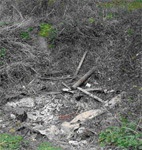 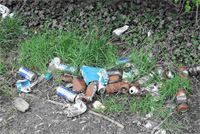 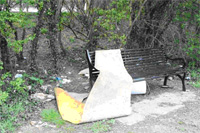
These photos were all taken in green and pleasant (!) parts of Earley. ‘Chuck it over the garden fence’ seems to be some people’s way of dealing with their rubbish or, perhaps ‘I can’t be bothered to go to the tip’, and Earley youth seems too tired to walk a few yards and put cans/bottles in the litter bin! Our local litter warden does his best, and we can’t blame the council. They don’t make the rubbish, people do, or at least a minority do. Don’t think Bill Bryson would be too impressed. As for graffiti...! Wok.Bor.Council phone contact 0118 974 6302/6303
We’re doing our bit. EEG carried out a litter pick-up in various venues in Earley, as part of RESCUE (Rivers & Environmental Spaces Clean Up Event) on Sunday 11 March. It was a better turn-out than last year. In the morning there were 38 people, including 4 Brownies, 2 Brown Owls and several family groups; they collected 42 large sacks. In the afternoon 15 volunteers managed another 22 sacks. Some of the items collected - a dustbin, a road cone, chairs, bundles of newspapers, a plastic wallet containing driving licence and debit Visa card, and an empty laptop bag (last two probably stolen goods). Helpers were shocked at the amount of litter in such a small area. We hope many more Earley residents will be involved in 2008. With over 30 000 residents we should be able to muster more than just over 50. Our grateful thanks go to Jean Hackett for organising this (see EEG website, Rescue 2007).
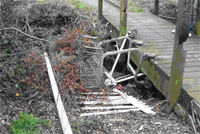 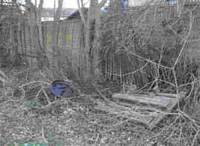 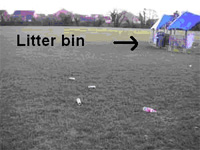 |
|
GREEN JARGON
Groundwater: Most of us have heard the term ‘groundwater’, especially during last year’s drought, but what exactly is it?
Water falls as rain and snow, soaks into the soil and, if the underlying rocks are permeable, into the bedrock below until this becomes saturated like a sponge. Water is then released slowly from the ‘sponge’ to feed springs, rivers, streams and wetlands. The upper surface of this saturated zone is called the water table. Permeable rocks like chalk, sandstone and limestone can hold a lot of water and are called aquifers. Water that stays near the top of an aquifer might only be underground for a month, but some of the deepest water is thought to be millions of years old. In the South-East in the chalk, the water can be 20,000 years old, originally falling as rain near the end of the last Ice Age.
Groundwater is very important as a source of drinking water. The proportion of total supply in Southern England is 72% while a third of all supplies in England comes from groundwater.
There are many reasons why groundwater is a good choice for a water supply, for example,
• The quality is good as the water is filtered and cleaned as it passes through the aquifer, therefore requiring less treatment to render it safe to drink.
• It is often present in areas where there are few other water sources.
• It does not need storage in expensive reservoirs.
However it is a limited resource. It normally gets topped up in winter when there is more rainfall, plants use less and because it is colder there is less evaporation. Groundwater levels dwindled after the recent series of dry winters which were followed by several hot summers. Springs, rivers and wetlands suffered.
Groundwater is vulnerable too. Pesticides, solvents and other chemicals leach into it and are difficult to remove. A report from the Environment Agency – Underground, Under Threat, says that 60% of our aquifers are at risk of failing EU water quality targets because of nitrate pollution from chemical fertilisers used in intensive agriculture. It sees the other major threat as increased demand, especially in the South-East (see www.groundwateruk.org and www.environment-agency.gov.uk). Anne Booth |
|
‘The Past is a Foreign Country’
A trip down Memory Lane by Alan Broodbank, our Chairman |
“If you take the first turning to the right and the second to the left you will probably find the forgotten England”: thus begins a chapter in my treasured copy of Tom Stephenson’s book “The Countryside Companion” published many decades ago. To those of us who in the 1940s and early ’50s lived alongside the primitive unmade track that even then was known as Hillside this statement was very true – you’d have probably ended up lost in the woods that we youngsters believed just went on for ever! After all, we’d all played in them throughout our short lives and knew them like the back of our hands, and nobody had yet claimed to have actually reached the other side!
Hillside Road was indeed a very rough and muddy affair, a description that could fairly be used to describe many of us children who were born and bred there. The lower end ended, as it does now, at the junction with Silverdale Road, although “Road” was hardly a fitting description for it, such a state was it in. To the Hillside Road folk this area was known as “The Bottom” and the people that lived there lived “down the Bottom”!
Turning right into Silverdale, the road headed westwards for about 150 yards towards the woods. There were just a few houses on the left and bungalows on the right before the road just seemed to peter out into the quagmire that was known simply as “The Muddy Patch”. This rarely dried out, even in summer, and was probably the location of a spring emanating from one of the numerous underground streams that criss-cross the area. A ditch that I suspect may have been constructed to drain it still exists. It runs, I think, alongside the garden of number 82 Silverdale Road, or thereabouts, and emptied into the stream from the lake adjacent to the tunnel where it emerges from the woods.
Between the end of the houses and the Muddy Patch, on the southern side, was a field about 50 yards wide which sloped all the way to the stream. The area is now occupied by numbers 74 – 82 Silverdale Road. This was my favourite spot of all, and we had wonderful times playing all manner of outdoor games: making dams in the stream, catching minnows, looking for birds’ nests, catching butterflies etc. etc. |
It was here that I found my only skylark’s nest, cunningly concealed beneath a grass tussock and which I found completely by accident. On the right hand (western) side of the field from Silverdale Road to about halfway down the field were a number of caravans. Each caravan had its own garden that backed on to the woods, and many were a riot of colour in the summer months. Below the caravans on the right was a huge bramble patch that provided plenty of free food in autumn. Beyond this, as you finally reached the stream, was the entrance to the woods. For some reason the stream had in the past been tunnelled at this point for about 20 yards, re-emerging about a third of the way across the field. The tunnel still exists, but has clearly been rebuilt in recent years.
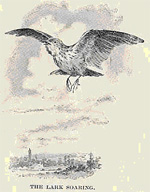 The combination of a warm southerly aspect, the abundance of mixed grassland, the proximity of a large area of mixed deciduous woodland, an unpolluted stream and the flowers in the caravan gardens made the whole area a rich haven for wildlife that, even at that tender age, I and many of my friends found to be of absorbing interest and gave us a lifelong love and respect of the countryside and its natural inhabitants. The nearest shop, Smiths, later Bryant’s, and then Cordell’s, at the top of Meadow Road, was fully aware of this and entered into the spirit of things by supplying butterfly and fishing nets at sensible prices. 6d (2.5p) to be precise! Not only that, but they also sold the “I-spy” books that were small enough to carry in one’s pocket and that were also very cheap. “I-spy butterflies and moths”, “I-spy birds” and “I-spy in pond and stream” were among the titles listed, and great sources of information they were. Brooke Bond tea cards were another source, and Snell’s grocery shop, on the other side of the main road, used to keep a stock of “swaps” for us to exploit. The combination of a warm southerly aspect, the abundance of mixed grassland, the proximity of a large area of mixed deciduous woodland, an unpolluted stream and the flowers in the caravan gardens made the whole area a rich haven for wildlife that, even at that tender age, I and many of my friends found to be of absorbing interest and gave us a lifelong love and respect of the countryside and its natural inhabitants. The nearest shop, Smiths, later Bryant’s, and then Cordell’s, at the top of Meadow Road, was fully aware of this and entered into the spirit of things by supplying butterfly and fishing nets at sensible prices. 6d (2.5p) to be precise! Not only that, but they also sold the “I-spy” books that were small enough to carry in one’s pocket and that were also very cheap. “I-spy butterflies and moths”, “I-spy birds” and “I-spy in pond and stream” were among the titles listed, and great sources of information they were. Brooke Bond tea cards were another source, and Snell’s grocery shop, on the other side of the main road, used to keep a stock of “swaps” for us to exploit.
(I suspect many Earley children today would willingly give up their computer games to have a childhood like Alan’s. Continues next issue.)
|
|
News update from member Stuart Hine, Manager of Insect Identification Service (IIS), Natural History Museum
Join the Great Stag Hunt: June is the best month for stag beetles, though they can be seen from the end of May - my best week has always been 3 - 10 June. Sightings can be passed onto the Peoples Trust for Endangered Species (PTES) who are again monitoring this species at: http://www.ptes.org/greatstaghunt
That said, any sightings can also be sent to me at: stuart@hine5.wanadoo.co.uk as I am also interested in seeing what the local picture is. Earley is certainly a hotspot as far as I am concerned, though there tend to be more at the north end as gardens are older and contain more over-mature trees and ensuing stumps for the beetle’s larvae to feed on. You have to put a bit of effort in to see them, but this is really no more than sitting in your garden from about 9.20 onwards for about an hour and keeping your eyes peeled (see article in Issue 5, Sept 2006).
This has very much been the year of the hornet - all manner of scaremongering stories about sightings of Asian hornets have featured in the press. What people have seen are queens of our native European hornet, Vespa crabro - which is becoming more commonly seen in towns, including Earley. See: http://www.nhm.ac.uk/about-us/news/2007/may/news_11635.html
Also, given the unseasonably warm/dry spring we have had, a good number of insect species have given an early show - this includes a good number of moth species, which have been recorded 3 - 5 weeks earlier than we would usually expect them.
Bee flies are becoming a more common sight in gardens - the Common Bee Fly, Bombylius major, is the one people will see in this area and it is a parasite of solitary bees. If this is becoming more common, we can only assume that the bees are doing equally well.
|
|
 Our project for surveying Earley’s veteran trees has so far recorded over sixty veterans, mainly oaks, and is at a fairly early stage. Their ages vary between 150 to 350 years, and many are reminders of the hedges that surrounded Earley’s fields or lined the old lanes. The biggest girth so far is an English Oak at 5.50m, c 350 years (anyone know of a bigger one?) and a Holm Oak, a massive 6.90m. Take time to notice them and be thankful that we have been spared these old-timers to grace our town. Volunteers are still needed to help with this project: phone 0118 9620004 Our project for surveying Earley’s veteran trees has so far recorded over sixty veterans, mainly oaks, and is at a fairly early stage. Their ages vary between 150 to 350 years, and many are reminders of the hedges that surrounded Earley’s fields or lined the old lanes. The biggest girth so far is an English Oak at 5.50m, c 350 years (anyone know of a bigger one?) and a Holm Oak, a massive 6.90m. Take time to notice them and be thankful that we have been spared these old-timers to grace our town. Volunteers are still needed to help with this project: phone 0118 9620004 |
|
Did you know?
It‘s a myth that you use less electricity by keeping your immersion heater on all the time. It’s much cheaper and consumes less energy if water is heated only when needed. If you have to add cold water because it’s too hot to use, you’re wasting energy. Consider fitting a timer. (from Green Books Guides) |
|
NEWS FROM BEYOND EARLEY |
“Spring will be a little late this year...” so goes the song but for ‘late’ substitute ‘early’. Earley members were seeing bumble bees in February and even a Red Admiral in January. Hawthorn, also known as May, flowered three weeks earlier in April; bluebells, traditionally blooming in May, were in flower in mid-April, and have you noticed how early the trees were in leaf this year? Spring is coming earlier each year.
Can you bee-lieve it! News that bees are deserting their hives, particularly in America, has reached Eastbourne’s planning committee, which has rejected planning approval for a mobile phone mast, until it is sure there is no danger to bees’ navigation systems by interference from radiation. Life would be unthinkable without our small pollinators.
BBOWT (Berkshire Buckinghamshire and Oxfordshire Wildlife Trust) will be featured on the BBC series The Nature of Britain later this year. Two reserves star: Warburg nr Henley and Chimney Meadows nr Bampton.
|
BBOWT points out that nature cannot live in a box and in March they launched the South East Living Landscapes project. The report is on http://www.wildlifetrusts.org, click Publications, then Free publications.
Signing our own death warrant with binge flying? So much for worrying about our carbon footprint! For the first time, more than 2.5 million commercial flights will be made round the world in May. This is a record. Experts say that carbon off-setting or emissions trading will not do the business and flying less is the only answer.
Re-introduction of extinct native species: A move to reintroduce beavers to Scotland has been vetoed by Scottish Executive. The claim is that powerful vested interests scuppered it. Also, much discussion about reintroducing wolves to parts of Scotland. Wolf supporters claim they do not deserve their terrible image, would keep deer numbers in check and be a tourist attraction. To find out more go to www.wolftrust.org.uk
|
EARLEY WILDLIFE SIGHTINGS |
Ruth: We often hear an owl at night from our back bedroom. We live in Chelwood Road and our back bedroom faces the Maiden Erlegh Lake.
Renee: We have heard owls occasionally in Leighton Park (at the back of our garden) almost each year since we moved in (1983). We hear them usually in the winter (December -March), but sometimes also in other months.
Sheila: 21 May. Two interesting sightings yesterday. Great spotted woodpecker on peanut feeder in morning, and a juniper shieldbug, Cyphostethus tristriatus, on Ipomoea seedling (identified by Stuart and put on website). This is becoming more common in southern counties. Today (22nd) woodpecker back again at about 8.30 am, probably a female because no red on nape of neck.
Grahame: 16 May Maiden Erlegh Local Nature Reserve, Instow Road, brown argus butterfly – only second time recorded on the reserve. Also a small copper butterfly on one of the wildflower meadows at Meadow Park which was very pleasing. Yesterday Gary took a call from someone who had a stag beetle on their doorstep.
Member’s mystery visitor in May: About the size of a blackbird only a little fatter, white head, white face, throat and chest, light grey all the way down its back to the tail; average size tail, greyish with little hints of white; pink legs, beak small, but it was in the garden for such a short time that I could not see its colour. It was feeding on the ground. We have looked in all our books and cannot identify it. Any ideas please - surely it must have come from the Lake?
One member suggested mistle thrush but this didn’t fit as the member could recognise this. Any ideas?
Garden Wildlife Recording Forms
Some of our members have been filling in forms giving details of their garden wildlife. The following is a very unscientific picture from generalities extracted from these irregular recordings in 2005 and 2006; ‘unscientific’ because there were no really continuous records for the two years, probably due to people’s commitments. Some members were no doubt more experienced at identification and pursued the activity more than others, and also some birds were easier to spot. It is appreciated that serious naturalists will not find much of value in the following, but for those less informed it gives an idea of what you might see in your garden at some time. You could think of the recordings as the bird equivalent of the Mass Observation history project on people and, who knows, perhaps in about 40 years time someone will find these forms of great interest for comparison!
In the main, people recorded birds plus a few mammals and butterflies. Bumble bees were just ‘bumble bees’, few having the expertise to tell one from another. The birds were very much those one would expect to visit our gardens. Without taking into account actual numbers, but noting just once the different species which were recorded on each monthly form, blackbird and robin were top, followed closely by blue tit. Pigeon was also at the top if those recorded as ‘pigeons’ and wood pigeons’ were lumped together. Other common, regular visitors were great tit, magpie, collared dove, chaffinch, sparrow and starling, with dunnock close behind. Slightly lower in the ‘pecking order’ (pardon the pun) were greenfinch, goldfinch, jay, thrush and long tailed tit. Less common visitors were crow, coal tit and wren. The great spotted woodpecker, green woodpecker, nuthatch, heron and blackcap were minor celebs making a few appearances. That champion mugger, the sparrowhawk, was recorded four times, once with its blackbird prey, another when it flew into a window but recovered and another chasing a blackbird. The rarities were lesser spotted woodpecker recorded by two members, both near woodlands, and one sighting each of reed bunting, willow warbler, pied flycatcher, bullfinch and, incredibly, grey cockatiel. One seagull deigned to accept bread on the lawn. It may be significant that two of the longest and most varied lists came from members near old woodlands.
Although a mostly commonplace list of birds, all of them are welcome in our gardens. As one member put it: “All this from the largest housing estate in Europe!” (we may have lost that record now). It would be nice if we could have a photo of each of the above birds on our website. If you have one, please upload it on to the Birds page, then Photos on EEG website.
|
A precocious season – but what of the migrant birds?
|
There can be few who didn’t notice that this spring was a little extraordinary. With high pressure dominating for the best part of six weeks, there was unusually sunny weather and little or no rain. Bulbs and other garden flowers were pulled into premature bloom and most of the early-season butterflies did very well too. Those more spectacular insects are a good pointer to the state of the larder for our nesting birds. Any evening walk taken in late April near any body of water will have revealed swarms of swirling protein packages, just ideal for the fledglings.
In short, the residents had a good start this year. In mid-April, Maiden Erlegh NR was really buzzing with activity, as tits, robins, thrushes, doves and the like all got on with the busy work of the breeding season. Crows, magpies, jays and woodpeckers too were in good form. There seemed to be more bird-life in those woods than a little, but the only migrant species were blackcaps and chiffchaffs, which winter relatively close by. It was a similar story for much of the month at Dinton Pastures.
Clearly, the good news of an early-season bonanza had not filtered south to the other migrants.
Most migrants set out northwards according to stimuli which cannot tell them that all in the UK is well-advanced. They are dependent on weather patterns and food supplies being right all the way along their route. The high-pressure system which established itself here late in March initially brought cold north-easterly winds, and even some snow flurries, conditions which will immediately hold up northward migration. As the winds became quieter easterlies towards the middle of the month, our false summer was established. However, migration seemed to be in suspense. Some birds trickled in on time, but the majority seemed to be later than usual. Paradoxically, the freakish warm spell seemed to raise our expectations of swallows and cuckoos and we felt empty without them. |
But it seems that poor weather around the Mediterranean was not sending the same signals as we had here, and for a time we were lacking the bulk of those migrants. Eventually, in the quieter winds, the mass movement of migrants pushed across the Channel, with birds arriving in good numbers, particularly in the third and fourth weeks of April. At Dinton Pastures, sand martins, sedge warblers and lesser whitethroats were soon joined by nightingales, then common whitethroats, garden warblers, and even a cuckoo or two. By the end of the month, we had our swallows, house martins, swifts and reed warblers too. Finally the birds seemed to fit the precocious season.
So were the migrants late? Not really. It was just that the summer weather was unusually early arriving. I reckon that if I can stand at Lavell’s Lake and listen to a nightingale, a blackcap and a song thrush (this one probably on a second brood), all singing against each other to the background of a cuckoo calling, it must be early May. And so it was!
 Northward migration continues throughout much of May so, as I write, many birds are still expected. I still have a lot to add to my year-list, such as spotted flycatcher, nightjar, hobby, but I have to admit that my list is already about two months ahead of last year. But that is down to me, rather than the birds, since the wonderful spell of weather this spring has had me outdoors and watching on a daily basis. It’s a hard life! Ray Reedman 7/5/07 Northward migration continues throughout much of May so, as I write, many birds are still expected. I still have a lot to add to my year-list, such as spotted flycatcher, nightjar, hobby, but I have to admit that my list is already about two months ahead of last year. But that is down to me, rather than the birds, since the wonderful spell of weather this spring has had me outdoors and watching on a daily basis. It’s a hard life! Ray Reedman 7/5/07
|
LOCAL FORTHCOMING EVENTS
June: A WALK FROM EARLEY TO DINTON PASTURES Join the group on a walk on Sunday 24 June. 2 - 5pm starting at the George, Loddon Bridge, hopefully ending up in time for tea at the DP cafe.
July: A GUIDED TOUR OF M.E. RESERVE Grahame Hawker, Senior Park Ranger for ETC knows it like the back of his hand and will tell us all about it. Sunday 15 July, 2 – 4 pm, meet at the Interpretation Centre, Instow Road. The Interpretation Centre can be found by taking Chelwood Road, off Beech Lane, then left into Instow Rd.
August: GREEN FAIR Saturday 4 August 10am-3pm Our usual fun day at Maiden Erlegh Nature Reserve. It gets bigger every year. Be there!
August: WOKINGHAM ENVIRONMENT DAY Saturday 18 August Dinton Pastures: Highlighting awareness of environmental issues. Find out how you can help the environment; see a working wind turbine, solar panels and drive an electric car or bicycle. Many environmentally focused organisations taking part. TIME: 10am-4pm COST: car parking £2. Incentives for arriving on foot/ bicycle Contact: Ian Gough 0118 974 6394. ian.gough@wokingham.gov.uk
September: Climate Change in Your Garden, with Dr. Michael Keith-Lucas Monday 17 September, venue and time to be decided (£1 entrance to cover expenses)
October: Farming and Wildlife, with Des Sussex Wednesday 17 October, venue and time to be decided (£1 entrance to cover expenses)
November: Talk on Birds by Ray Reedman on Wednesday 14 November, venue and time to be decided (£1 entrance to cover expenses)
December: Christmas Social Members slides, quiz and Christmas refreshment. Everyone welcome.Tuesday 18 December 7.30 to 9 pm at Interpretation Centre.
Berkshire Biodiversity Courses (All courses free but £10 deposit required)
Identifying Minibeasts Saturday 16 June 2007, 10am - 4pm Sandhurst Community Centre, Sandhurst: Ponds Saturday 14 July 2007, 10am-4pm Binfield Memorial Hall, Binfield, Bracknell.
Practical woodland management Saturday 8 September, 10am - 4pm Prospect Park, Reading.
Contact Lindsay Watts tel- 01865 788309 email- lindsaywatts@bbowt.org.uk if you would like to book a place. People will need to give their name, address, email, phone and a £10 deposit cheque (payable to BBOWT) This is the address they should send it to: BBOWT Course Bookings, Freepost OF2051, Oxford, OX4 4BR
|
Bits and Pieces
Can you help Dr Fox find his cubs? University professor appeals for help from the Reading public
Dr Phil Baker, a biological scientist and lecturer in conservation at the University of Reading, has asked members of the public to help research how many fox cubs are being born in Reading's urban environment. He wants to record how many are in the Reading area; he needs members of the public, schools, business and householders to help. Please contact Dr Baker direct on p.j.baker@reading.ac.uk or on 0118 378 4566 if you see fox cubs. Also, he wants sightings of dead foxes.
Dragonflies: Information has been added to our website, following the talk by Des Sussex, where you can also download a pdf file of the complete booklet. Try http://www.earleyenvironmentalgroup.co.uk/Insects/Dragonflies.asp.
EEG Committee Members can be found on www.earleyenvironmentalgroup.co.uk under Contacts, or phone 0118 962 0004.
For Wildlife Survey Forms, go to the website or phone Earley Town Council 0118 986 8995
Comments or contributions to the newsletter to: sheila.crowson@ntlworld.com or 2 Reeds Avenue, Earley, RG6 5SR. We would welcome short contributions from members to the newsletter.
If you know anyone who would like to join EEG, membership forms are available from Earley Town Council, 0118 986 8995, on the website under Downloads, or send an e mail to Liz Wild liz@helva.plus.com. Please inform Liz if you intend to change e-mail or address at 50 Kenton Rd, Earley RG6 7LG.
Can you offer active help to the Group? Phone 0118 9620004 if you can. We need people with some expertise to undertake, surveys of small habitats in Earley, or do a hedge survey, or be able to give occasional help.
|
SUPPORT YOUR LOCAL SHOPS
The True Food Co-op, Silverdale Centre
There is now a True Food Co-op operating in Earley. Their mission is to take low cost organic food out to the people, bypassing the supermarkets which charge a lot for organics They hold markets at the Silverdale Centre on the second & fourth Fridays in the month, 5pm to 8.15pm They have a website giving dates www.truefood.coop/truefood.html
Pet Fayre 9 Maiden Lane Centre Lower Earley
A small independent shop, with bird feeders of all kinds, a variety of bird feed, large bags of which the shop is willing to deliver locally, or pick it up in your car from the back of the shop Tel 0118 9266512, or email enquiries@petfayre-reading.co.uk. |
|
Thanks to ORACLE for reproducing our newsletter on recycled paper. Oracle is the world's second largest software company, situated at Thames Valley Business Park in Earley. Oracle UK is environmentally accredited to the ISO14001 standard which confirms Oracle has considered and acted against its environmental impacts. As part of their corporate social responsibility they support a number of local groups, including us. They have offered to co-operate with us on a number of future joint projects, which we haven’t yet been able to pursue. They have given us valuable support in reproducing the hard copies of our newsletter in colour, as well as printing off posters, and membership leaflets for us to distribute to libraries and the like. |
|